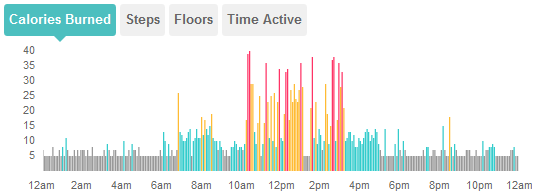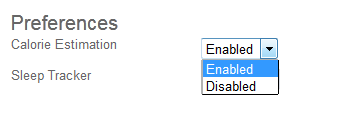The Fitbit device is a small accelerometer that you wear all day and night to track your movements. It gathers information such as calorie burn, steps taken, stairs climbed, and the way that you sleep.
You might be wondering how your Fitbit determines your calories burned for the day or what your caloric intake should be. Let’s break it down.
BMR
Your BMR (Basil Metabolic Rate) is the number of calories burned when you are resting, and therefore the number of calories your body needs to sustain regular body functions, such as breathing. This number does not include any exercise that you do throughout the day, and is dependent on age, height, weight, gender, and other factors.
According to the Fitbit Sourcecode API, Fitbit uses this standard MD Mifflin-St Jeor equation:
9.99 * weight(Kg) + 6.25*height(Cm) - 4.92*age(years) + s
(where s is +5 for males and -161 for females)
EER
Your EER (Estimated Energy Requirements) are the number of estimated calories that you burn based on your BMR plus calories from a typical non-exercise day, such as getting ready for work, working at a desk job for 8 hours, and stopping by the store on the way home. EER is based on a formula published by the FDA and used by other government agencies to estimate the calories required by an individual based on their age, height, weight, and gender. Your EER is greater than your BMR since your BMR only takes into account the calories burned by your body just for it to exist.
According to the Fitbit Sourcecode API, the formula is:
MALE: EER = 864 - 9.72 x age(years) + 1.0 x (14.2 x weight(kg) + 503 x height(meters)) FEMALE: EER = 387 - 7.31 x age(years) + 1.0 x (10.9 x weight(kg) + 660.7 x height(meters))
Attached is an Excel Spreadsheet for the FitbitCalculations.
If you don’t have Microsoft Excel, you can access the file online on Google Drive – FitbitCalculations.
Calorie Estimation
The Fitbit website has a couple of settings that you can change in your account.
Set Your Calorie Estimation Preferences
On the Fitbit website, log in to your account and go to Settings > Personal Info. In the Preferences section, you can enable or disable Calorie Estimation.
If you have a Fitbit and have synced recently, the calories will match the Fitbit data. This includes your BMR, activity calories, and calories from manually-logged activities. Manually-logged activities replace the Fitbit calorie estimate for that time frame, so there’s no need to worry about double counting the calories.
- If you enable Calorie estimation:
- If you do not have enough logged activities to overcome the EER estimate, your EER is displayed and an asterisk (*) will be displayed next to your calorie burn number
To view a definition of your calorie estimation, hover your pointer over the asterisk (*). - If your BMR + calories from activities is greater than 80% of your EER, the calculated number is displayed
- If you do not have enough logged activities to overcome the EER estimate, your EER is displayed and an asterisk (*) will be displayed next to your calorie burn number
- If you disable Calorie estimation:
- Your BMR + calories from activities is displayed
Change Your Calorie Estimate Setting
On your Food tab of the Log page, you can change your Calorie Estimate Setting to Personalized or Sedentary.
The Personalized setting uses your past activity history to estimate your calorie burn for the day and increases or decreases if you’re more or less active tthan usual.
The Sedentary setting starts out low and lets you earn calories as you are active throughout the day.
Note: If you use this setting, you will start the day with a very low calorie estimate.
If you choose the Sedentary setting, Fitbit is projecting how many calories you should eat based on your BMR, your activity, and your goal. For example, if you want to lose 1 pound per week, you must have a daily calorie deficit of 500 calories. The purpose of this section is for you to enter foods you have eaten so that Fitbit will tell you how many more calories you can eat that day. I don’t recommend this. This gives you a mental “out”. It leads you to believe that you can eat poorly and then go burn it off. This is not a healthy mental path to weight loss.
I know my real BMR. Can I change it?
At this time, there is no setting that will allow you to change your BMR. The Fitbit BMR is determined by your sex, age, weight, and height. What that means, however, is if you change your entries, you change your BMR. Here’s how.
Open the FitbitCalculations spreadsheet. Enter your real data in the yellow blocks to see which BMR Fitbit uses for you. If it is wrong (and mine is off by over 150 calories), change values in the yellow blocks of the spreadsheet until the BMR is correct. Keep in mind that Fitbit uses some of the information for other purposes. Your sex, height, and weight are used to calculate your BMI, for example. In my case, I had to increase my age by over 30 years to correct it. Once you know what you need to change, go to the Fitbit Settings > Personal Info > Body Info and make the change.
Important! – You will not see an immediate change. Your calories burned for the day are already set and in the database. Set the change and wait at least a day to see the difference.







